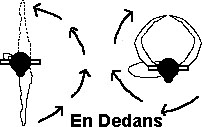Frequently misspelled and endlessly confused, let’s go over these important dance directions!
There are typically two situations for which en dehors and en dedans are used in ballet and throughout most theatrical dance training.
- When indicating the direction of rotation in a pirouette, or turn.
- When describing the circular pathway of the leg in movements such as rond de jambe à terre or en l’air.
A bird’s eye view helps to illustrate the sometimes puzzling concepts:
En dehors
In dance, this term means outward. When turning, as the figure on the right above is showing, this outward rotation is relative to the supporting (sometimes called standing) leg. The dancer is thought of as moving “outward” toward whichever leg is lifted in the turn or, in other words, “away” from the supporting leg. Either way, the concept can be confusing for a new dancer. Sometimes thinking too hard about the explanation can confuse things further.
Wrapping one’s head around the idea of pathway is somehow easier. In rond de jambe à terre (on the ground), for instance, you would consider the pathway of the toe as it creates a semi-circle on the floor which, in en dehors, would trace from the front of the body to the back. When “working” or gesturing with the right leg, the action moves clockwise. With the left, counterclockwise.
Going back to pirouettes, it helps to apply this concept of pathway to the lifted knee. For pirouette en dehors, when “working” or gesturing with the right leg, the knee traces a clockwise pattern. When the left leg is lifted, the rotation is counterclockwise.
En dedans
As in right versus left, if it isn’t en dehors then it must be en dedans. Simply reversing the concept above will explain en dedans, which means inward in ballet. The toe in rond de jambe would begin to the back (or behind the body) and travel in a circular pathway toward the front. This time, when the right leg is working the toe orbits counterclockwise. The left moves clockwise from 6 o’clock to 12. Similarly, pirouettes with the right leg lifted rotate counterclockwise and visa versa when the left leg is up.
A few things to keep in mind:
It may help you to think of the knee drawing a circle around the axis of your body in your pirouette en dedans. However, be careful! In a classical turn, do not think of the knee as leading the body around. The leg must remain fully turned-out regardless of the direction you are turning.
Yes, this same terminology applies to fouetté turns, piqué turns (the most common of which are en dedans – read more on piqué turns here), turns à la seconde, grand rond de jambe, and rond de jambe en l’air. I won’t go into their explanations this time. If the concepts of en dehors and en dedans are not yet cemented in your mind, it is likely you aren’t ready to try all of these more advanced movements anyway!
The title of the post is an oft-used memory device reminding the dancer that en dehors means outward. Have you or your teachers used other tactics to remember the difference between en dehors and en dedans? Share them in the comments below the post!
Nichelle Suzanne is a writer specializing in dance and online content. She is also a dance instructor with over 20 years experience teaching in dance studios, community programs, and colleges. She began Dance Advantage in 2008, equipped with a passion for movement education and an intuitive sense that a blog could bring dancers together. As a Houston-based dance writer, Nichelle covers dance performance for Dance Source Houston, Arts+Culture Texas, and other publications. She is a leader in social media within the dance community and has presented on blogging for dance organizations, including Dance/USA. Nichelle provides web consulting and writing services for dancers, dance schools and studios, and those beyond the dance world. Read Nichelle’s posts.



